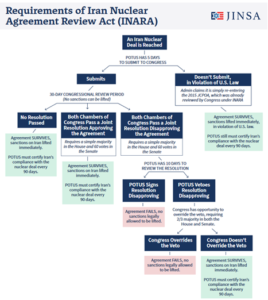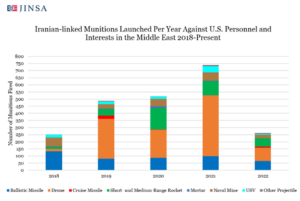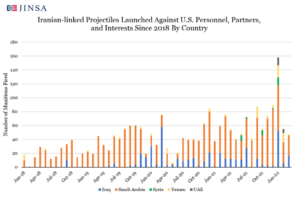Iran Summary – March 2022
About the Iran Summary: The Jewish Institute for National Security of America’s (JINSA) Gemunder Center produces a monthly tracker providing timely information and graphics illustrating Iran’s aggressive and destabilizing activities.
March 2022 Summary: With the Biden administration continuing to claim that time is running out to reach a nuclear agreement, Iran’s 60 percent enriched uranium stockpile and weapons potential surged. At the same time, Iran continued its regional aggression campaigns, notably striking Saudi critical infrastructure and a target near the American consulate in Erbil, Iraq.
Response to Ukraine Crisis: Iran doubled down on its support for the Russian invasion of Ukraine, which it views as an opportunity to diminish U.S. regional influence.
- In a televised speech on March 1, Iran’s Supreme Leader Ayatollah Khamenei claimed that the United States was the “root cause” of the Russian invasion of Ukraine and refrained from blaming Russia for the invasion.
- On March 24, Iranian Foreign Minister Hossein Amir-Abdollahian visited Damascus, where he met with Syrian President Bashar al-Assad and affirmed Iran’s support for Russia’s invasion of Ukraine. Later, Amir-Abdollahian traveled to Beirut, where he met with Hezbollah Secretary General Hassan Nasrallah.
Nuclear: As the eighth round of JCPOA talks drag on indefinitely, Iran continued to amass low-enriched uranium at dangerous levels. Iranian nuclear scientists were spotted conducting nuclear research activities in Iranian-occupied Syria. Members of Congress have grown increasingly concerned that the Biden administration will not submit a nuclear deal for review, as required under the Iran Nuclear Agreement Review Act (INARA).
- On March 3, a report by the International Atomic Energy Agency (IAEA) showed that the stock of 60 percent-enriched uranium amassed by Iran in contravention of the 2015 nuclear deal had doubled from 15.5kg to 33.2kg—three quarters of the amount needed, if further enriched, for one nuclear warhead.
- The IAEA reported on March 11 that Iran plans to irradiate a third of its stock of 60 percent-enriched uranium to produce molybdenum-99.
- As of March 18, Iran had only irradiated 2.1kg, roughly six percent of its stock.
- Iran’s reasons for taking this action are not known. It might be to attempt and create a civilian justification for producing and maintaining their stockpile of 60 percent enriched uranium and/or reprocessing capabilities that could be used to pursue a plutonium path to a nuclear weapon.
- Molybdenum-99 is used to produce other isotopes used in nuclear medicine. However, the United States has sought to develop ways to produce the material without the use of highly enriched uranium.
- Once irradiated, both the molybdenum and the enriched uranium can be recovered through reprocessing. If Iran seeks to develop the capabilities such reprocessing capabilities, it might later be able to apply them to extract plutonium from spent nuclear fuel and potentially divert it for use in a nuclear weapon.
- On March 14, a report published by the Institute for Science and International Security reported that Iran has amassed enough low-enriched uranium (4.5, 20, and 60 percent) to produce enough weapons-grade uranium for four nuclear weapons.
- On March 22, U.S. Special Envoy for Iran Robert Malley and Middle East Coordinator at the National Security Council Brett McGurk provided classified briefings to the Senate Foreign Relations Committee (SFRC) on the negotiations with Iran.
- Afterward, SFRC member Sen. Ben Cardin (D-MD) expressed concerns that the White House was considering lifting the foreign terrorism organization (FTO) designation against Iran’s Islamic Revolutionary Guard Corps (IRGC). Instead, Cardin argued “that designation should remain.”
- Ranking Member Sen. Jim Risch (R-ID) similarly cautioned that “both Republicans and Democrats that I’ve talked to” are highly concerned about the “disgusting” lack of transparency from the Biden administration about the nuclear talks.
- The mounting congressional concerns over the White House’s lack of transparency in its negotiations with Iran are consistent with the 2015 Iran Nuclear Agreement Review Act (INARA), which stipulates that the White House must submit any nuclear arms-related agreement made with Iran via the P+5 to Congress for review. Given the novel elements introduced in this new series of talks, e.g., FTO delisting and massive sanctions relief, the emerging agreement is patently distinct from the 2015 JCPOA, meaning it would trigger INARA.

- The Syrian Observatory for Human Rights reported on March 29 that Iranian nuclear scientists had arrived to conduct nuclear research at the Al-Sawannah site, a highly fortified, Iranian-controlled de facto enclave in the Eastern Palmyra mountain .
Regional Aggression: Iran and its proxies conducted multiple attacks against Saudi critical infrastructure and adjacent international waterways, an unprecedented attack against alleged Israeli targets in Iraqi Kurdistan, and major troop movements in Iranian-controlled areas of Syria.
- On March 5, the Iran-backed Houthi rebels launched a new major offensive to take the strategic city of Marib, the Yemeni government’s last bastion in the north of the country, killing at least one Yemeni civilian in the process.
- The Houthi rebels also launched at least one missile into the Red Sea on March 5, raising concern among U.S. officials that the Houthis could strike one of the many commercial vessels that frequently transit the waterway.
- The Royal Saudi Air Defense Forces (RSADF) reportedly intercepted a number of Houthi-launched explosive-laden drones targeting the kingdom’s southern border region on March 7.
- On March 9, the RSADF reportedly intercepted a Houthi-launched explosive-laden drone targeting the kingdom’s southern Jazan region.
- A Houthi-launched explosive-laden drone struck an oil refinery in the Saudi capital of Riyadh on March 10, although the refinery’s operations were not affected.
- On March 13, Iran fired a barrage of ballistic missiles at a compound near the U.S. consulate in Erbil, the capital of Iraq’s autonomous Kurdistan Region, claiming that the target was the site of Israeli intelligence operations.
- After the previous day’s Iranian missile attack on Iraqi Kurdistan, on March 14, Iranian militias across Syria undertook major troop redeployment and repositioning.
- The Houthi rebels launched missiles and drones at several Saudi energy and water desalination facilities on March 19, causing a temporary drop in output at a refinery in the Saudi Red Sea town of Yanbu.
- On March 25, the Houthi rebels launched ten explosive-laden drones and a ballistic missile at the coastal Saudi city of Jeddah, striking a Saudi Aramco oil storage facility.


Cyber: Iran continued to wage its global cyberterrorism campaign, targeting Israeli websites, sites in Turkey, and hacking the phone of the Israeli Mossad head’s wife.
- A March 14 Iranian-backed cyber-attack took Israeli government websites offline for several minutes before the Israeli National Cyber Directorate restored them.
- On March 10, Talos, CISCO’s cyber intelligence division, linked a wave of cyberattacks targeting Turkey and other Asian countries to the Iranian-backed MuddyWater advanced persistent threat (APT) umbrella group.
- Iran-backed hackers reportedly breached the phone of Mossad Head David Barnea’s wife on March 16.
Domestic/Human Rights: Amid continued protests, Iran has persisted in its brutal campaign to repress and control its population, including persecution and targeted killing of minority groups, curtailing internet freedom, mass executions and denial of medical care to political prisoners, and denying women full participation in Iranian society.
- On March 1, a group of UN human rights experts urged the Iranian government to abandon an internet censorship bill proposed last month, warning that the bill would bring Iran closer to a “digital wall.” If passed the bill would likely block any websites operated by foreign companies remaining in Iran, require Iranians to use IDs to access the internet, and criminalize the use of Virtual Private Networks (VPNs).
- The Center for Human Rights in Iran reported on March 3 that Iran’s continued practice of denying medical treatment to imprisoned political and civil rights activists is part of a deliberate effort to crush domestic dissent. At least two imprisoned activists, Baktash Abtin and Adel Kianpour, have died this year after being denied medical care.
- On March 11, the UN released a groundbreaking report decrying the criminalization of Baha’i people in Iran, where Baha’is face violent persecution, government-backed smear campaigns, and discrimination in education and employment.
- On March 14, Iranian security forces killed a Kurdish mother and son in Iran’s western Kermanshah province.
- On March 17, the UN special rapporteur on Iran published figures showing that Iran executed at least 280 people during 2021.
- An elderly Australian-Iranian man died in Tehran’s notorious Evin prison on March 20 after being denied urgent medical care.
- On March 21, Iranian security forces violently cracked down on Nowruz protests in Iran’s West Azerbaijan province, which is primarily populated by Azeris and Kurds.
- Female Iranian soccer fans were denied entry to the Iran-Lebanon world cup qualifier match in the Iranian city of Mashhad on March 29. The female fans, who had been allowed to queue for and purchase tickets the previous day, protested outside the stadium and were sprayed with tear gas and pepper spray by Iranian security forces.
Recent JINSA Publications on Iran:
- April 1: “Expect More Iranian Aggression with New Nuclear Deal,” Blaise Misztal and Ari Cicurel, JINSA NatSec Brief
- March 24: “A ‘Disgusting’ Lack of Transparency on New Iran Nuclear Deal,” Jonathan Ruhe and Andrew Ghalili, JINSA NatSec Brief
- March 19: “Why Biden Should Exit the Iran Talks,” Blaise Misztal and Jonathan Ruhe, National Interest
- March 14: “As Nuclear Talks Pause, Iran Escalates,” Ari Cicurel and Andrew Ghalili, JINSA NatSec Brief
- March 11: “U.S. Tensions with Saudi Arabia and UAE,” JINSA NatSec Brief
- March 9: Infographic: Never-Ending Iran Deadlines (Updated)
- March 7: “To Offset Dangerous Iran Deal, Expedite KC-46As to Israel,” Ari Cicurel
- March 2: “Israel’s Failed US Policy,” Michael Makovsky, PhD, The Jerusalem Post
JINSA’s Previous Iran Nuclear Talks Updates:
- Iran Nuclear Talks Update 3/29
- Iran Nuclear Talks Update 3/24
- Iran Nuclear Talks Update 3/22
- Iran Nuclear Talks Update 3/16
- Iran Nuclear Talks Update 3/15
- Iran Nuclear Talks Update 3/11
- Iran Nuclear Talks Update 3/7
- Iran Nuclear Talks Update 3/3
- Iran Nuclear Talks Update 3/2
- Iran Nuclear Talks Update 3/1